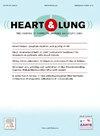基于机器学习的急性心肌梗死患者12个月复工评估系统
IF 2.6
4区 医学
Q2 CARDIAC & CARDIOVASCULAR SYSTEMS
引用次数: 0
摘要
复工是急性心肌梗死(AMI)后恢复的重要指标,准确识别复工率低的患者对及时干预至关重要。目的建立预测急性心肌梗死患者恢复工作的机器学习(ML)模型。方法采用“急性心肌梗死后心衰发生率与最佳治疗”数据库对539例AMI患者进行回顾性研究。患者随机分为训练组和验证组(7:3)。使用7种ML算法建立训练队列的预测模型。通过受试者工作特征曲线下面积(AUC)、准确性、F1评分和Brier评分来评估模型的性能。结果纳入539例AMI患者(中位[IQR]年龄:50.0[45.0,54.0]岁;其中男性505例(93.7%),出院后1年内复工431例(80.0%)。表现最好的模型是eXtreme gradient boosting, AUC为0.821 (95% CI, 0.736-0.907),准确率为0.802 (95% CI, 0.733-0.861), F1评分为0.873。基于该模型建立的复工评分和分层能有效地将患者分为低、中、高概率组(33.3% vs. 60.0% vs. 91.7%, P <;0.001)。该模型部署在一个开放的网站https://amirtw.streamlit.app/上,为医务人员提供了一个方便的评估和分析工具。结论建立了一种新的ML复工率模型,有助于识别复工率较低的患者,可能成为AMI患者有效的管理工具。本文章由计算机程序翻译,如有差异,请以英文原文为准。
Machine learning-based return-to-work assessment system for acute myocardial infarction patients within 12 months
Background
Returning to work is a critical indicator of recovery after acute myocardial infarction (AMI), and accurate identification of patients with low return-to-work rates is critical for timely intervention.
Objectives
To develop a machine learning (ML) model for predicting the return-to-work in AMI patients.
Methods
A retrospective study of data from 539 AMI patients was conducted using the Incidence Rate of Heart Failure After Acute Myocardial Infarction With Optimal Treatment database. Patients were randomly divided into training cohort and validation cohort (7:3). Seven ML algorithms were used to establish a prediction model for the training cohort. Model performance is evaluated by the area under the receiver operating characteristic curve (AUC), accuracy, F1 score, and Brier score.
Results
This study included 539 AMI patients (median [IQR] age, 50.0 [45.0, 54.0] years; 505 (93.7 %) were male, and 431 (80.0 %) returned to work within one year after discharge. The best-performing model was eXtreme gradient boosting, which achieved an AUC of 0.821 (95 % CI, 0.736–0.907), an accuracy of 0.802 (95 % CI, 0.733–0.861), and an F1 score of 0.873. The return-to-work score and stratification established based on this model can effectively distinguish patients into low, medium, and high probability groups (33.3 % vs. 60.0 % vs. 91.7 %, P < 0.001). The model was deployed on an open website https://amirtw.streamlit.app/, providing a convenient evaluation and analysis tool for medical staff.
Conclusion
A new return-to-work ML model was developed, which may help identify patients with low return-to-work rates and may become an effective management tool for AMI patients.
求助全文
通过发布文献求助,成功后即可免费获取论文全文。
去求助
来源期刊

Heart & Lung
医学-呼吸系统
CiteScore
4.60
自引率
3.60%
发文量
184
审稿时长
35 days
期刊介绍:
Heart & Lung: The Journal of Cardiopulmonary and Acute Care, the official publication of The American Association of Heart Failure Nurses, presents original, peer-reviewed articles on techniques, advances, investigations, and observations related to the care of patients with acute and critical illness and patients with chronic cardiac or pulmonary disorders.
The Journal''s acute care articles focus on the care of hospitalized patients, including those in the critical and acute care settings. Because most patients who are hospitalized in acute and critical care settings have chronic conditions, we are also interested in the chronically critically ill, the care of patients with chronic cardiopulmonary disorders, their rehabilitation, and disease prevention. The Journal''s heart failure articles focus on all aspects of the care of patients with this condition. Manuscripts that are relevant to populations across the human lifespan are welcome.
 求助内容:
求助内容: 应助结果提醒方式:
应助结果提醒方式:


